牛津译林版(2019)必修第二册Unit 2 Be sporty,be healthy Extended reading课件(30张PPT)
文档属性
| 名称 | 牛津译林版(2019)必修第二册Unit 2 Be sporty,be healthy Extended reading课件(30张PPT) | 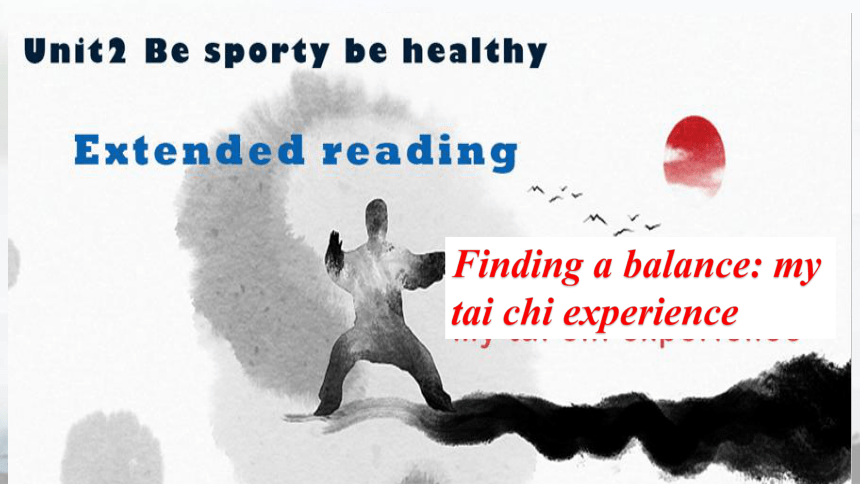 | |
| 格式 | zip | ||
| 文件大小 | 65.2MB | ||
| 资源类型 | 教案 | ||
| 版本资源 | 牛津译林版(2019) | ||
| 科目 | 英语 | ||
| 更新时间 | 2022-11-08 12:19:48 | ||
图片预览

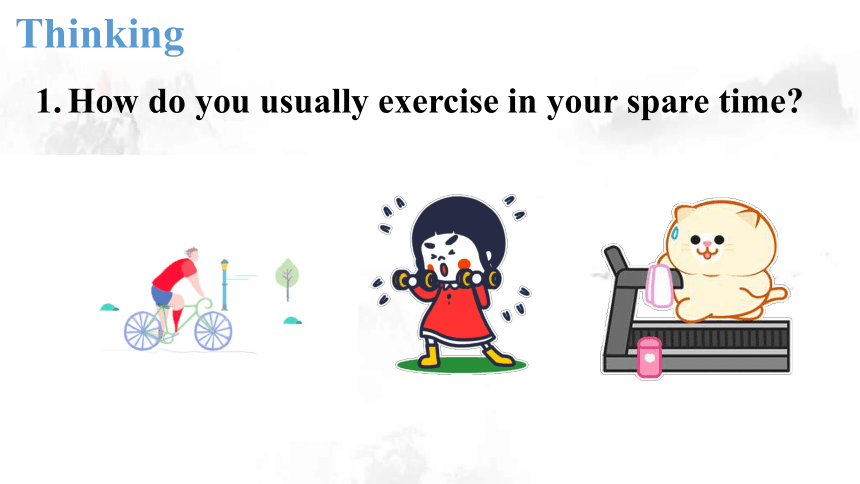
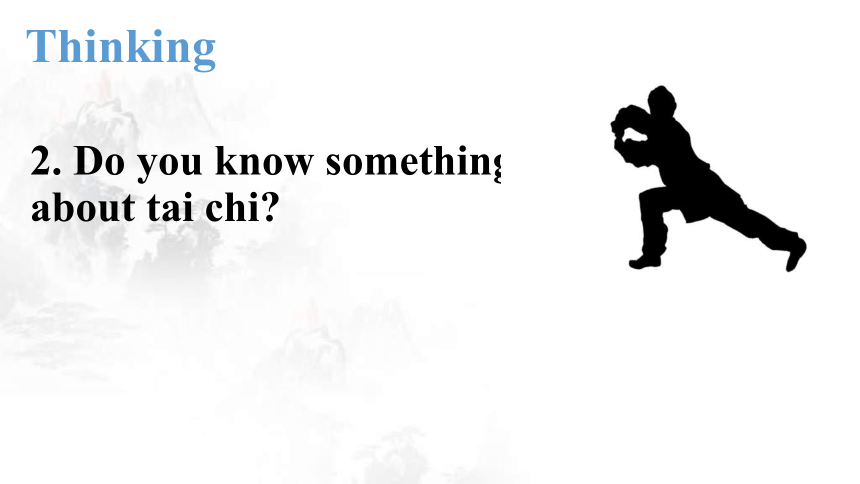
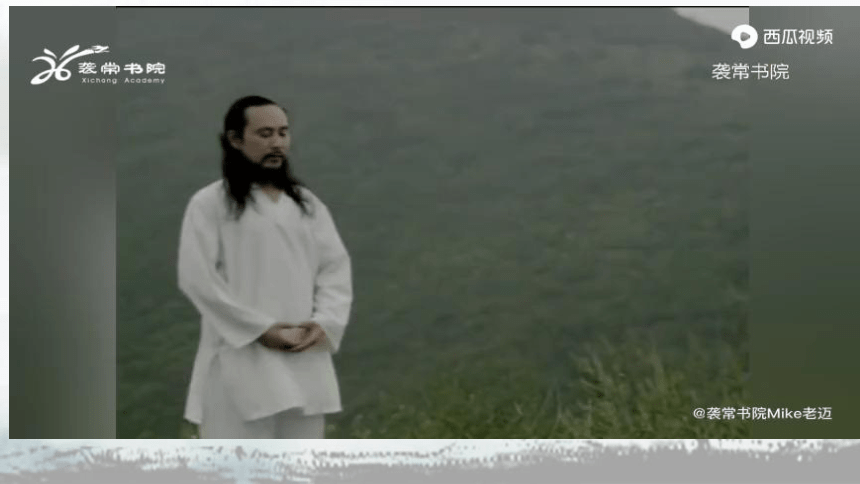
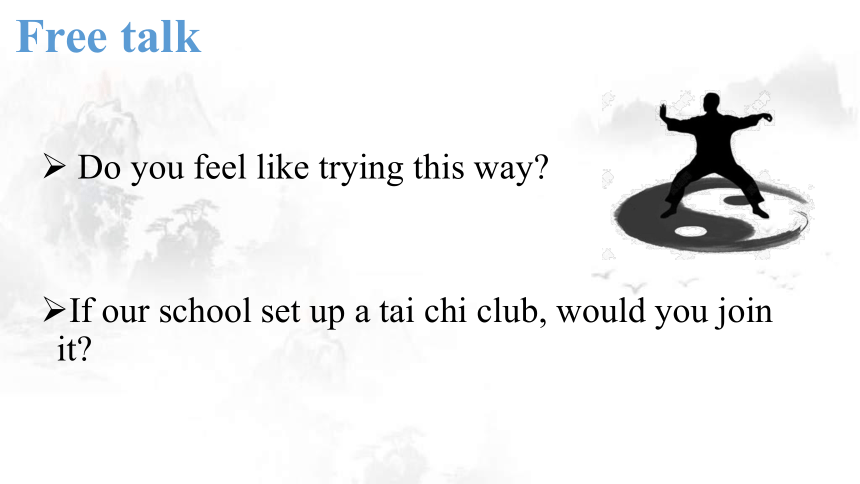
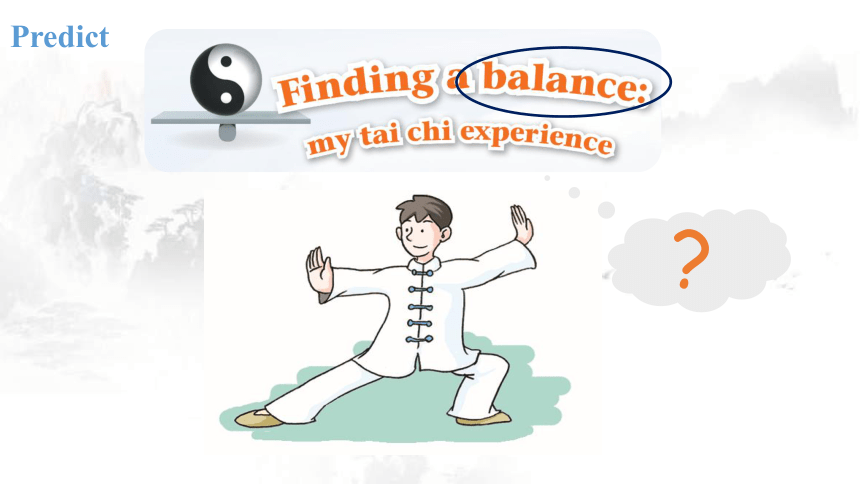
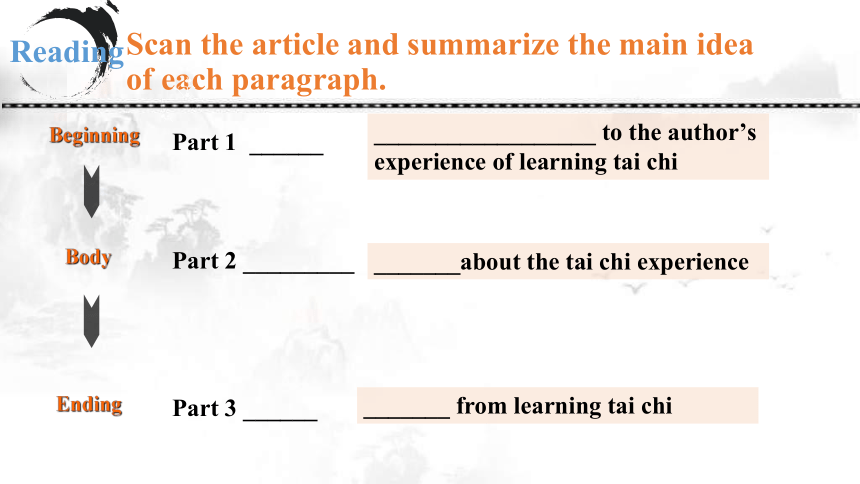
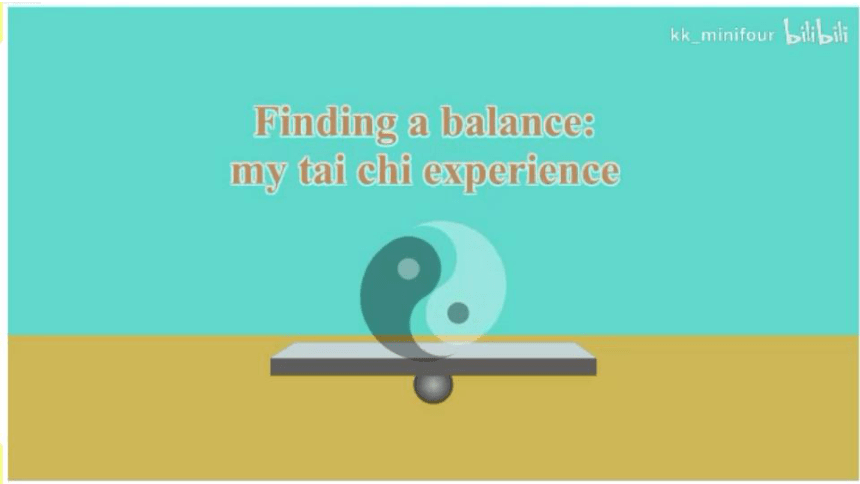
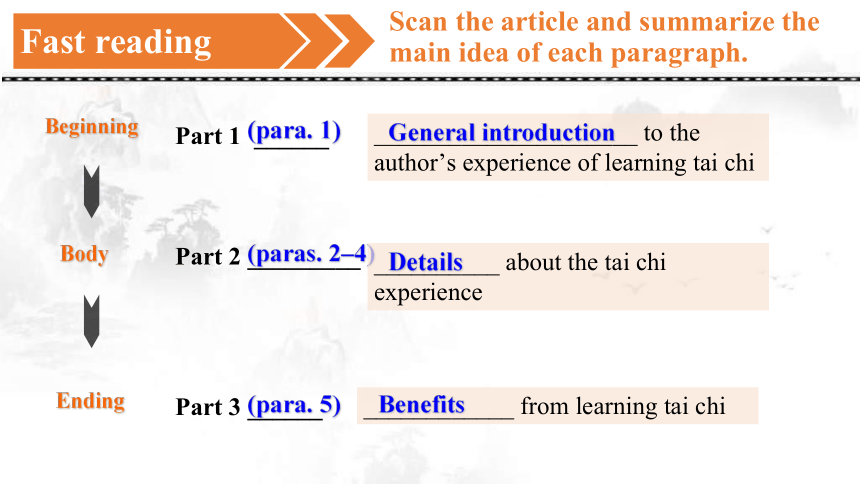
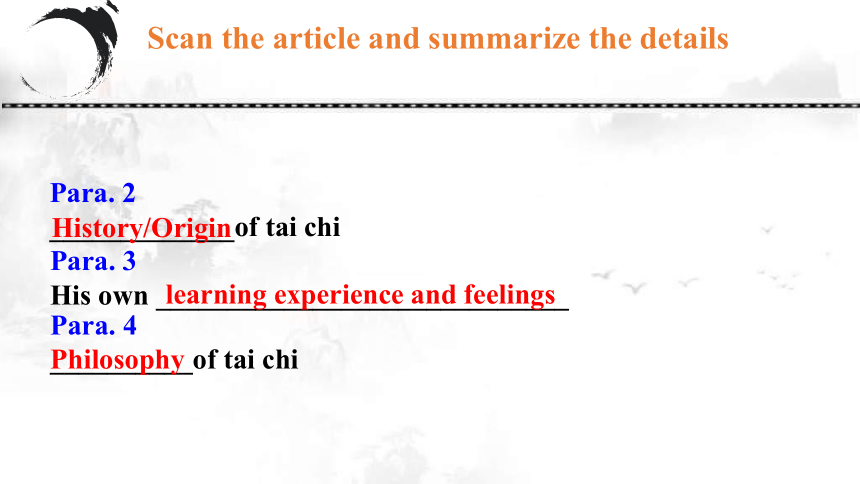
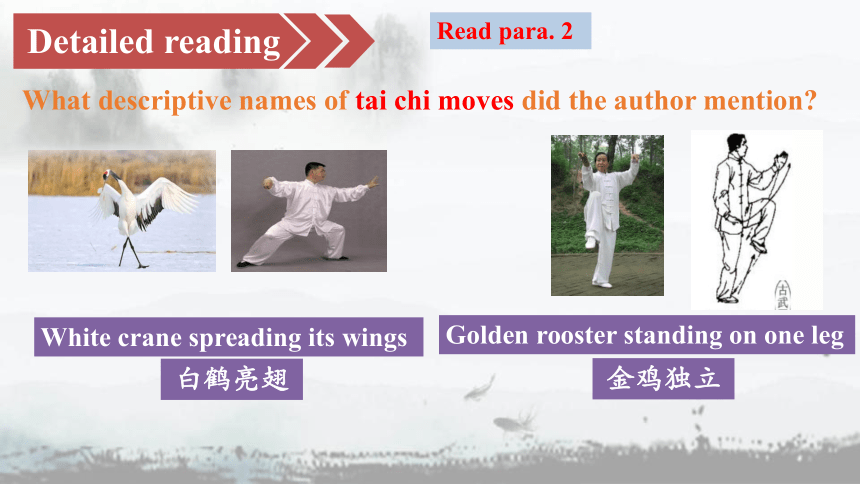
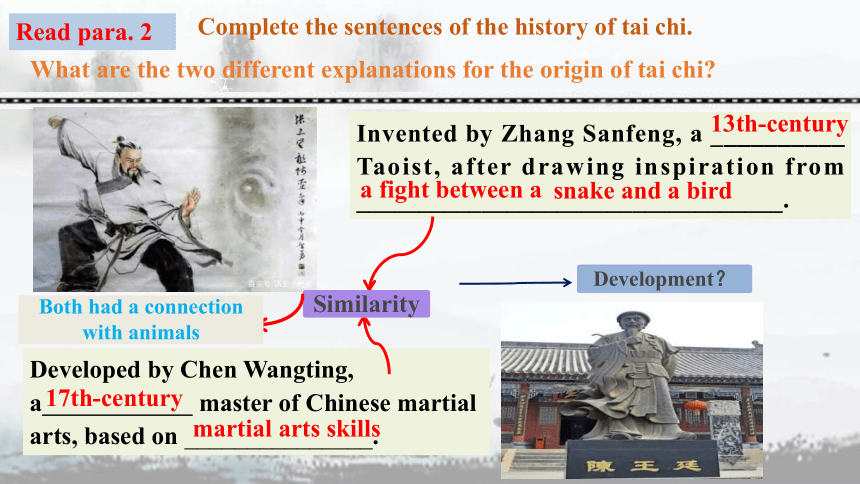
文档简介
(共30张PPT)
Finding a balance: my tai chi experience
Thinking
How do you usually exercise in your spare time
Thinking
2. Do you know something about tai chi
Free talk
Do you feel like trying this way
If our school set up a tai chi club, would you join it
Predict
Scan the article and summarize the main idea of each paragraph.
Beginning
Body
Ending
Part 1 ______
Part 2 _________
Part 3 ______
__________________ to the author’s experience of learning tai chi
_______about the tai chi experience
_______ from learning tai chi
Reading
Scan the article and summarize the main idea of each paragraph.
Part 1 ______
Part 2 _________
Part 3 ______
Beginning
Body
Ending
(para. 1)
(para. 5)
(paras. 2–4)
_____________________ to the author’s experience of learning tai chi
General introduction
__________ about the tai chi experience
____________ from learning tai chi
Details
Benefits
Fast reading
Para. 4
__________of tai chi
Para. 3
His own _____________________________
Para. 2
_____________of tai chi
History/Origin
learning experience and feelings
Philosophy
Scan the article and summarize the details
Read para. 2
What descriptive names of tai chi moves did the author mention
White crane spreading its wings
Golden rooster standing on one leg
白鹤亮翅
金鸡独立
Detailed reading
Invented by Zhang Sanfeng, a __________ Taoist, after drawing inspiration from __________________________________.
Complete the sentences of the history of tai chi.
Developed by Chen Wangting,
a master of Chinese martial
arts, based on _______________.
13th-century
a fight between a
snake and a bird
17th-century
martial arts skills
Read para. 2
What are the two different explanations for the origin of tai chi
Similarity
Both had a connection with animals
Development?
Chen-style, Yang-style,
Wu-style, Sun-style
Both had a connection with animals
History
Understanding the history and culutre of tai chi
How
Draw inspiration from a fight between a snake and a bird
Develop tai chi based on martial arts skills. Chinese martial arts have a long-standing practice of imitating animals.
Development
Similarity
Chen Wangting,
a 17th-century master of Chinese martial arts
Zhang Sanfeng,
a 13th-century Taoist
Who
Some styles of tai chi:
Q: How did the author solve his problem after the first few classes
What was the author’s problem
How did the author solve his problem
How was the author after he solved the problem
He found himself bored and aching from doing the same moves over and over again.
His coach taught him how to relax his muscles and focus on
peace of mind while performing the routine.
His balance and flexibility slowly improved.
He was able to do more difficult moves.
His love for tai chi returned stronger than ever.
Read para. 3
Essence(精髓) of tai chi
Root
C_________________ (1)
forwards and ___________ (4)
up & ______ (5)
left & _____ (6)
breathing in and ____________ (7)
Keep (8)
…
Y (3)
hinese philosophy
in
ang
backwards
down
right
balance
breathing out
Complete the following diagram.
the unity of opposites
Read para. 4
The practice of tai chi aims to maintain the balance in the body through
______________
opposite movements
The Chinese culture behind tai chi
How do we understand the sentence there is no shadow without light Why is it used here
Where there is light, there is shadow.
The writer uses this example to explain the equal and opposite forces which make up the world can’t live without the other.
Exploration
Read para. 4
Can you make up more sentences to explain the philosophy of yin and yang
There is no right without wrong.
There is no fairness without unfairness.
There is no white without black.
There is no day without night.
There is no success without failure.
The Chinese culture behind tai chi
Exploration
Read para. 4
What positive effects does practising tai chi have on the author
Sleep better at night
Be more energetic during the day
Feel happier and more confident
Relax his mind and enable him to stay cool in stressful situations
He is sure he will continue to practise tai chi and enjoy the benefits it has brought him.
Read para. 5
time
interest
time
interest
time
interest
time
interest
A
B
C
D
Choose the one which best describes the change in the author’s attitudes.
Detailed reading
Detailed reading
Q1: What was the author’s tai chi experience like
At first
During the first few classes
After those first few classes
One year later
I always believed tai chi was for old people and __________.
hesitated
I found they were ______________, and learned a lot about the _______
of tai chi.
fun and easy
history
I found myself __________________, but with the help of the coach, my love for tai chi _________. I also learned about the ancient Chinese culture behind it.
bored and aching
returned
I found that tai chi had a __________ effect on me.
positive
fun and easy
hesitated
in the first few classes
after learning the basics
the coach taught me what to do
bored
happier and more confident
interest
time
The author ______________(过去常常做某事)think tai chi was just for old people, and he hesitated about _________ (practice) it at first. ___________(gradual), he came to find tai chi more and more interesting and eventually ________________(爱上)it. Furthermore, he began to understand the culture behind tai chi and was able to apply its philosophy _____ his everyday life.
used to
practising
Gradually
fell in love with
to
Summary
Do you think tai chi will get more popular among teenagers Why or why not
I think tai chi will get more popular among
teenagers because:
tai chi is good for physical and mental health;
tai chi brings about a state of physical and mental balance;
tai chi broadens horizons and enriches knowledge on the ancient Chinese culture.
I think tai chi will not get more popular among
teenagers because:
tai chi isn’t to teenagers’ taste because of its slow pace;
tai chi takes much time;
tai chi is not practical for teenagers with heavy study pressure.
Life itself is a balanced, complementary gains and losses, which is a dynamic relationship.
生活本来就是一种平衡,是得失互补的动态关系。
Writing
假定你是李华,你们学校正在开展各种社团活动。请你给你的朋友Tom写一封邮件,向他介绍太极,并邀请他一起参加太极俱乐部。内容包括:
1. 太极的历史及文化;
2. 练习太极对身心的好处。
注意:1. 词数80左右:
2. 可适当增加细节,以使行文连贯。
Dear Tom,
How’s everything going I’m writing to invite you to attend the Tai Chi Club held by our school.
Tai Chi, which is deeply rooted in the Chinese philosophy of yin and yang, enjoys great popularity. Aiming to maintain the balance in the body through opposite movements, it does good to both physical and mental health. Anyone can practice and benefit from tai chi. I’m sure you will develop a great interest in this gentle exercise.
Looking forward to your reply.
Yours,
Li Hua
A sample
Finding a balance: my tai chi experience
Thinking
How do you usually exercise in your spare time
Thinking
2. Do you know something about tai chi
Free talk
Do you feel like trying this way
If our school set up a tai chi club, would you join it
Predict
Scan the article and summarize the main idea of each paragraph.
Beginning
Body
Ending
Part 1 ______
Part 2 _________
Part 3 ______
__________________ to the author’s experience of learning tai chi
_______about the tai chi experience
_______ from learning tai chi
Reading
Scan the article and summarize the main idea of each paragraph.
Part 1 ______
Part 2 _________
Part 3 ______
Beginning
Body
Ending
(para. 1)
(para. 5)
(paras. 2–4)
_____________________ to the author’s experience of learning tai chi
General introduction
__________ about the tai chi experience
____________ from learning tai chi
Details
Benefits
Fast reading
Para. 4
__________of tai chi
Para. 3
His own _____________________________
Para. 2
_____________of tai chi
History/Origin
learning experience and feelings
Philosophy
Scan the article and summarize the details
Read para. 2
What descriptive names of tai chi moves did the author mention
White crane spreading its wings
Golden rooster standing on one leg
白鹤亮翅
金鸡独立
Detailed reading
Invented by Zhang Sanfeng, a __________ Taoist, after drawing inspiration from __________________________________.
Complete the sentences of the history of tai chi.
Developed by Chen Wangting,
a master of Chinese martial
arts, based on _______________.
13th-century
a fight between a
snake and a bird
17th-century
martial arts skills
Read para. 2
What are the two different explanations for the origin of tai chi
Similarity
Both had a connection with animals
Development?
Chen-style, Yang-style,
Wu-style, Sun-style
Both had a connection with animals
History
Understanding the history and culutre of tai chi
How
Draw inspiration from a fight between a snake and a bird
Develop tai chi based on martial arts skills. Chinese martial arts have a long-standing practice of imitating animals.
Development
Similarity
Chen Wangting,
a 17th-century master of Chinese martial arts
Zhang Sanfeng,
a 13th-century Taoist
Who
Some styles of tai chi:
Q: How did the author solve his problem after the first few classes
What was the author’s problem
How did the author solve his problem
How was the author after he solved the problem
He found himself bored and aching from doing the same moves over and over again.
His coach taught him how to relax his muscles and focus on
peace of mind while performing the routine.
His balance and flexibility slowly improved.
He was able to do more difficult moves.
His love for tai chi returned stronger than ever.
Read para. 3
Essence(精髓) of tai chi
Root
C_________________ (1)
forwards and ___________ (4)
up & ______ (5)
left & _____ (6)
breathing in and ____________ (7)
Keep (8)
…
Y (3)
hinese philosophy
in
ang
backwards
down
right
balance
breathing out
Complete the following diagram.
the unity of opposites
Read para. 4
The practice of tai chi aims to maintain the balance in the body through
______________
opposite movements
The Chinese culture behind tai chi
How do we understand the sentence there is no shadow without light Why is it used here
Where there is light, there is shadow.
The writer uses this example to explain the equal and opposite forces which make up the world can’t live without the other.
Exploration
Read para. 4
Can you make up more sentences to explain the philosophy of yin and yang
There is no right without wrong.
There is no fairness without unfairness.
There is no white without black.
There is no day without night.
There is no success without failure.
The Chinese culture behind tai chi
Exploration
Read para. 4
What positive effects does practising tai chi have on the author
Sleep better at night
Be more energetic during the day
Feel happier and more confident
Relax his mind and enable him to stay cool in stressful situations
He is sure he will continue to practise tai chi and enjoy the benefits it has brought him.
Read para. 5
time
interest
time
interest
time
interest
time
interest
A
B
C
D
Choose the one which best describes the change in the author’s attitudes.
Detailed reading
Detailed reading
Q1: What was the author’s tai chi experience like
At first
During the first few classes
After those first few classes
One year later
I always believed tai chi was for old people and __________.
hesitated
I found they were ______________, and learned a lot about the _______
of tai chi.
fun and easy
history
I found myself __________________, but with the help of the coach, my love for tai chi _________. I also learned about the ancient Chinese culture behind it.
bored and aching
returned
I found that tai chi had a __________ effect on me.
positive
fun and easy
hesitated
in the first few classes
after learning the basics
the coach taught me what to do
bored
happier and more confident
interest
time
The author ______________(过去常常做某事)think tai chi was just for old people, and he hesitated about _________ (practice) it at first. ___________(gradual), he came to find tai chi more and more interesting and eventually ________________(爱上)it. Furthermore, he began to understand the culture behind tai chi and was able to apply its philosophy _____ his everyday life.
used to
practising
Gradually
fell in love with
to
Summary
Do you think tai chi will get more popular among teenagers Why or why not
I think tai chi will get more popular among
teenagers because:
tai chi is good for physical and mental health;
tai chi brings about a state of physical and mental balance;
tai chi broadens horizons and enriches knowledge on the ancient Chinese culture.
I think tai chi will not get more popular among
teenagers because:
tai chi isn’t to teenagers’ taste because of its slow pace;
tai chi takes much time;
tai chi is not practical for teenagers with heavy study pressure.
Life itself is a balanced, complementary gains and losses, which is a dynamic relationship.
生活本来就是一种平衡,是得失互补的动态关系。
Writing
假定你是李华,你们学校正在开展各种社团活动。请你给你的朋友Tom写一封邮件,向他介绍太极,并邀请他一起参加太极俱乐部。内容包括:
1. 太极的历史及文化;
2. 练习太极对身心的好处。
注意:1. 词数80左右:
2. 可适当增加细节,以使行文连贯。
Dear Tom,
How’s everything going I’m writing to invite you to attend the Tai Chi Club held by our school.
Tai Chi, which is deeply rooted in the Chinese philosophy of yin and yang, enjoys great popularity. Aiming to maintain the balance in the body through opposite movements, it does good to both physical and mental health. Anyone can practice and benefit from tai chi. I’m sure you will develop a great interest in this gentle exercise.
Looking forward to your reply.
Yours,
Li Hua
A sample
